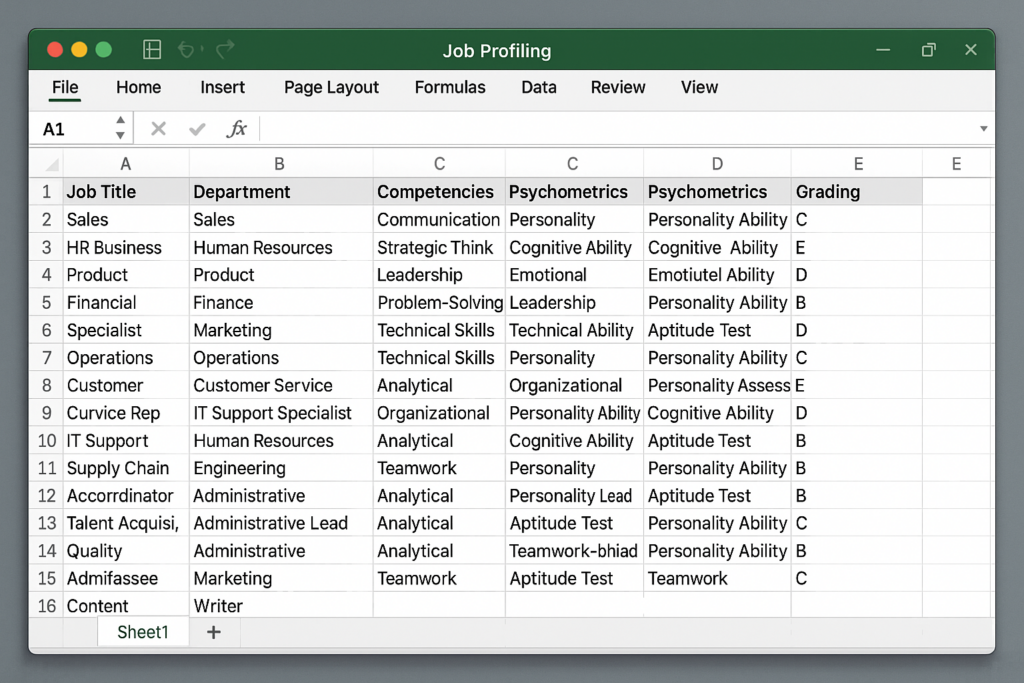- 16 Helpful Career Site Self-Service Tools for You - December 18, 2025
- Last Week I Had a Viral LinkedIn Post — But Why? (And What TA Folks Can Learn From It) - December 8, 2025
- Job Description Process Improvement: How One Workflow Fix Saved 1,200 JDs from Chaos - December 4, 2025
Most HR teams don’t choose Excel because it’s perfect. They choose it because it’s there.
But what happens when a spreadsheet you set up “just to get started” becomes the only thing standing between you and legal compliance?
The Excel Era: Simple, Then Slippery

This story starts like many others. A fast-scaling consumer goods company in South Africa had an Organizational Development (OD) lead managing job profiles in Excel.
We’re talking hundreds of roles. Each one is tied to competencies, psychometrics, grading structures, and internal assessments. It wasn’t just a spreadsheet. It was “the system”.
And for a while, it worked. Updates went through one person. Edits happened manually. People waited for their turn.
Then the Bottleneck Hit
As the business grew, that spreadsheet ballooned. Each new hire or role change meant another manual update. Another duplicated entry. Another tab. Another formula.
Before long, they were juggling:
- Hundreds of job profiles across departments
- Recruiters relying on the OD team to confirm grading info
- Talent teams needing psychometric data tied to roles
- Legal pushing for standardized competencies for equal pay audits
One person. One spreadsheet. And a whole lot of pressure.
The Hidden Costs of Managing Job Profiles in Excel
The team started to feel the cracks. Not all at once, but slowly:
- Hiring delays: Recruiting teams couldn’t move forward until profiles were updated.
- Inconsistencies: Data in Excel didn’t always match what was in their ATS or comp systems.
- Compliance gaps: South African pay equity laws require clear, consistent competencies — Excel made that nearly impossible to enforce.
- Burnout: The OD lead was the single point of failure. If they were out, everything stalled.
This wasn’t just annoying. It was risky. And it made something as foundational as a job profile feel like a roadblock instead of a tool for growth.
What HR Leaders Can Learn from This
If you’re managing job profiles in Excel right now, this isn’t a guilt trip. It’s a heads-up. Because we’ve seen this movie before and we know how it ends.
Here’s what this South African team learned the hard way (so you don’t have to):
1. Excel is for math, not HR strategy
It’s great when you’re working with 5 roles. Not so much at 500. There’s no version of “Excel 2.0” that turns it into a sustainable profiling system.
2. Build a central job library before you need one
Once the volume is high, it’s like trying to change your car’s engine while driving 80 mph. Get ahead of it. Create a system that scales.
3. Don’t be the bottleneck (or let someone else become it)
Sharing the load is smart. Spreading accountability reduces risk and protects the whole org when someone’s out.
4. Automate compliance (because you’re only human)
Manually updating competencies across hundreds of profiles opens the door for human error and legal risk. Automation locks in consistency.
What Happened Next?
This company’s HR leadership team realized the stakes were too high to keep going the way they were. They reached out to us at Ongig. (That’s where I come in…this story came from a real sales call.)
We walked them through how a centralized, dynamic job profile library could eliminate the bottleneck and give everyone (from recruiters to compliance) a single source of truth.
It was clear they weren’t alone. This Excel thing? It’s everywhere. But it doesn’t have to be forever.
Why I Wrote This
If you’re managing job profiles in Excel today, you’re not broken, but your process might be.
I wrote this because too many HR teams are stuck using tools that weren’t built for them. Ongig was. We help teams move beyond spreadsheets with centralized, automated, and compliant job libraries that scale.
Request a demo to see how we can help you ditch the Excel bottleneck and scale smarter.
FAQs
Is Excel bad for managing job profiles?
Not initially — but it becomes risky at scale. Excel lacks version control, automation, and compliance checks, which can create major issues.
What’s the alternative to managing job profiles in Excel?
A centralized job description software like Ongig, where you can create, update, and manage roles in one place — without duplication or delay.
How does Excel cause compliance issues?
In countries like South Africa with equal pay laws, inconsistent competencies across roles can lead to audits or fines — especially if tracked manually in Excel.
Can Ongig replace Excel for job profiling?
Yes. Ongig creates a dynamic job library with role-specific competencies, grading, and even psychometric tie-ins — all in one system.
When should I move off Excel?
If you’re managing more than 50 roles or need to meet compliance standards, it’s time to upgrade your tools before bottlenecks grow.
